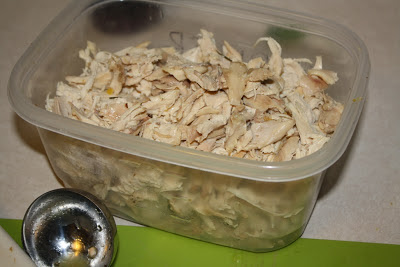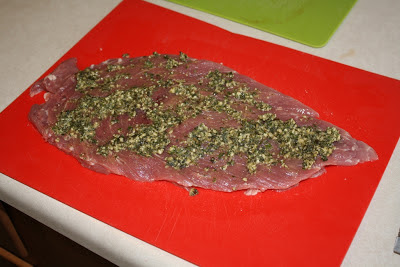Lately, I've been doing a near-weekly chicken roast. For a few hours of effort on Sunday, my weekday meals become super simple and really tasty.
Here's my reasoning: buying chicken in parts means you're buying a chicken that has been processed more. Roasting a whole chicken is easy and very customizable. And the best part is that you can use the inedible parts to make a
delicious stock. So when I roast a chicken on Sunday, that means I can either do easy salads topped with chicken during the week, or I have the perfect base for a chicken soup (also very customizable!). A roast chicken can be done so many ways, with a variety of spices. In the summer, I recommend
beer can chicken on the grill. This week, rosemary lemon chicken sounded perfect for salads. If I was going to make chicken tortilla soup with the meat, I'd swap out the rosemary for cilantro and the lemons for limes and follow the recipe below.
I've had a deep longing for fresh herbs lately. Last week I stuffed a
pork tenderloin with last summer's frozen
homemade basil pesto. This week I'm slathering rosemary lemon butter on a chicken, using dried rosemary from last summer's garden.
Zest a lemon or two and chop up some rosemary (you can use either fresh or dried rosemary, but remember that the fresh stuff is more potent).
Add it to some softened butter. Best practice: leave it on the counter to come up to room temp. In a pinch you can soften it in the microwave. Just don't melt it!
I won't blame you if you stop right here, toast some bread, and put a smear of the herbed butter on toast. Super fragrant! If the butter is unsalted, add some salt and pepper to the herbed butter. If you're using salted butter there's no need to add more salt.
Remove any organs / neck that came with the chicken. Wash the (thawed) chicken under cool water, inside and out. Place it in a baking dish (or 9x13 pan).
You don't have to do this, but I usually do: loosen the skin from the breast and put some of the butter between them. Or just slather the whole thing with the butter, including the extremities and crevices. If the bird is cold, the butter will harden up - in this case it is better to do small quantities of butter at a time.
Slice the lemons in half and juice them over the chicken. Best practice: use a lemon juicer so you don't have to worry about seeds. Here's the best shot I got of juicing with my right hand and taking a photo with my left hand...
Stuff the lemon halves and the remaining rosemary into the cavity.
Chop one large or two small onions into large chunks and tuck them in around the chicken, adding one or two chunks to the cavity. I put about half a cup of water in the pan just to make sure there is plenty of moisture available.
Roast at 400*, roughly 20 min per pound of bird, until a meat thermometer reads at least 170* in the thickest part of the meat. Check it every hour or half hour, and if (when) it starts to get too brown, cover it loosely in foil.
Rosemary Lemon Roast Chicken
Ingredients:
- 1 whole chicken, thawed
- 2 or 3 lemons*
- 1/2 cup fresh rosemary* (or 1/4 cup dried rosemary leaves. Use less if rosemary is ground)
- 1/2 tsp pepper
- 1 stick of butter (1/2 cup)
- 1 large or 2 small onions
*Can also use cilantro and limes in place of rosemary and lemons to make a chicken more suitable for chicken tacos, chicken tortilla soup,
buffalo chicken dip, etc.
Instructions:
1. Zest a lemon or two and chop up most of the rosemary. Add it to some softened butter. Add the pepper to the butter. If using unsalted butter, add a pinch of salt.
2. Remove
any organs / neck that came with the chicken. Wash the (thawed) chicken
under cool water, inside and out. Place it in a baking dish (or 9x13
pan).
3. Slather the chicken with the butter, including the
extremities and crevices. If the bird is cold, the butter will harden
up - in this case it is better to do small quantities of butter at a
time.
4. Slice the lemons in half and juice them over the
chicken. Best practice: use a lemon juicer so you don't have to worry
about seeds. Stuff the lemon halves and the remaining rosemary into the cavity.
5. Chop
one large or two small onions into large chunks and tuck them in around
the chicken, adding one or two chunks to the cavity. I put about half a
cup of water in the pan just to make sure there is plenty of moisture
available.
6. Roast at 400*, roughly 20 min per pound
of bird, until a meat thermometer reads 170* in the thickest part of the
meat. Check it every hour or half hour, and if (when) it starts to get
too brown, cover it loosely in foil.
7. Remove from oven and let stand for 10 minutes.
Next post will be on what to do with the inedible parts (neck, organs, carcass). In the meantime, enjoy rosemary lemon chicken on salads, in wraps, or served on its own with a side of rice pilaf or mixed vegetables.
This method - with lemons and rosemary - has been the most tender chicken I've ever done. Fall-off-the-bone (in fact, one of the wings fell off the bird while roasting!) tender dark meat; one of easiest birds I've ever disassembled.












































